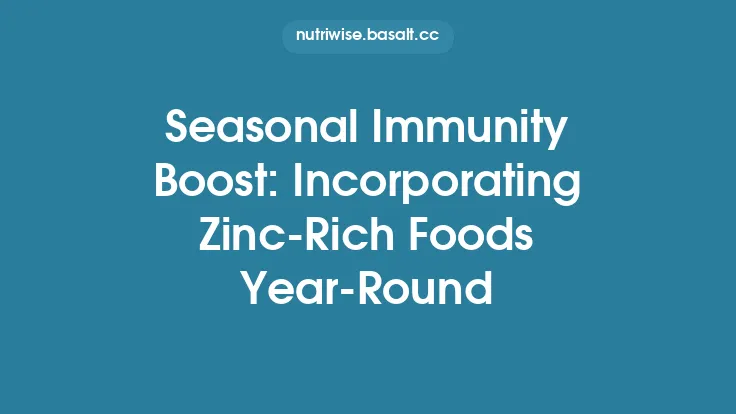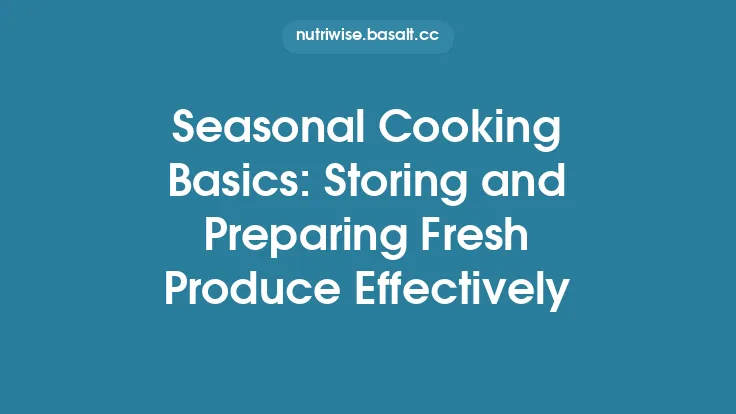Summer arrives with a burst of color, aroma, and flavor that transforms markets, gardens, and kitchens alike. The long, sun‑filled days coax a unique set of fruits and vegetables to ripen at their nutritional peak, offering a natural pharmacy of vitamins, minerals, phytochemicals, and fiber. Across continents, cultures have long celebrated this bounty with festivals, rituals, and culinary customs that not only honor the harvest but also harness its health‑promoting properties. Understanding the science behind these summer staples and the traditions that surround them can empower you to make the most of the season’s offerings, supporting immunity, metabolic balance, and overall vitality.
Nutrient Highlights of Summer Produce
| Nutrient | Why It Matters | Typical Summer Sources |
|---|---|---|
| Vitamin C | Potent antioxidant; supports collagen synthesis, iron absorption, and immune function. | Strawberries, kiwi, bell peppers, tomatoes, citrus (early summer varieties). |
| Beta‑carotene & Lycopene | Provitamin A compounds; protect cellular membranes from oxidative damage; support eye health. | Carrots, sweet potatoes, watermelon, tomatoes, apricots. |
| Electrolytes (Potassium, Magnesium) | Regulate fluid balance, nerve transmission, and muscle contraction—crucial during hot weather. | Bananas, cantaloupe, avocado, zucchini, cucumbers. |
| Polyphenols (Flavonoids, Anthocyanins) | Anti‑inflammatory and cardioprotective; modulate gut microbiota. | Blueberries, blackberries, cherries, red grapes, purple cabbage. |
| Dietary Fiber (Soluble & Insoluble) | Promotes satiety, stabilizes blood glucose, and nourishes beneficial gut bacteria. | Peas, beans, corn, figs, figs, and many summer squashes. |
| Vitamin B‑complex (B6, Folate) | Essential for neurotransmitter synthesis, red blood cell formation, and DNA repair. | Avocado, leafy greens (e.g., Swiss chard), beans, and melons. |
These nutrients are not isolated; they often act synergistically. For example, the vitamin C in strawberries enhances iron absorption from plant‑based sources like spinach, while the lycopene in tomatoes becomes more bioavailable when paired with a modest amount of dietary fat (e.g., olive oil), a principle reflected in many traditional summer dishes.
Cultural Celebrations of the Summer Harvest
Across the globe, summer’s abundance is woven into cultural narratives, festivals, and communal meals:
- Japan’s Obon Festival – While primarily a time to honor ancestors, the season’s fresh produce—such as edamame, cucumbers, and watermelon—features prominently in family gatherings, symbolizing renewal and the fleeting nature of life.
- Mediterranean “Festa della Frutta” – In regions of Italy and Southern France, towns hold fruit fairs where peaches, apricots, and figs are displayed, tasted, and exchanged, reinforcing local agricultural identity.
- Mexican “Noche de San Juan” – Celebrated on June 24th, this night includes the preparation of “agua fresca” using watermelon, cantaloupe, and hibiscus, believed to cleanse the body and spirit.
- American “Fourth of July Barbecue” – Grilled corn on the cob, tomato salads, and berry desserts reflect the seasonal peak of these crops, while also serving as a communal expression of national pride.
These events do more than showcase food; they embed nutritional wisdom within social rituals, encouraging collective consumption of nutrient‑dense foods at a time when the body’s needs for hydration and antioxidant protection are heightened.
Key Summer Fruits and Their Health Benefits
1. Watermelon (Citrullus lanatus)
- Composition: >90 % water, rich in citrulline, lycopene, and potassium.
- Health Impact: Citrulline is a precursor to arginine, supporting nitric oxide production and vascular dilation, which can help regulate blood pressure. Lycopene’s antioxidant capacity is linked to reduced risk of certain cancers and skin protection from UV damage.
2. Peaches & Nectarines
- Composition: Vitamins A & C, dietary fiber, phenolic compounds.
- Health Impact: The fiber content aids glycemic control, while phenolics exhibit anti‑inflammatory activity, beneficial for joint health during active summer months.
3. Berries (Strawberries, Blueberries, Raspberries)
- Composition: High in anthocyanins, vitamin C, and folate.
- Health Impact: Anthocyanins improve endothelial function and may enhance cognitive performance. Folate supports methylation pathways critical for DNA repair.
4. Cherries
- Composition: Melatonin, quercetin, potassium.
- Health Impact: Melatonin assists in regulating circadian rhythms, which can be disrupted by long daylight hours. Quercetin’s antihistamine properties may alleviate seasonal allergies.
5. Citrus (Early‑season Oranges, Limes, Lemons)
- Composition: Vitamin C, flavanones, essential oils.
- Health Impact: Flavanones like hesperidin improve lipid profiles and possess anti‑platelet activity, supporting cardiovascular health.
Essential Summer Vegetables and Their Role in Wellness
1. Tomatoes
- Key Phytochemicals: Lycopene, beta‑carotene, vitamin K.
- Mechanism: Lycopene’s antioxidant action reduces oxidative stress in skin cells, while vitamin K supports bone health—a crucial factor for active outdoor pursuits.
2. Bell Peppers (All Colors)
- Nutrients: Vitamin C (especially in red peppers), vitamin B6, capsanthin.
- Benefit: Capsanthin, a carotenoid unique to red peppers, has been shown to protect retinal cells, making peppers a natural ally for eye health.
3. Zucchini & Summer Squash
- Composition: Low-calorie, high in water, magnesium, and lutein.
- Health Angle: Lutein accumulates in the macula, protecting against age‑related macular degeneration, while magnesium supports muscle function and electrolyte balance.
4. Corn (Sweet Varieties)
- Nutrients: Complex carbohydrates, fiber, thiamine, and antioxidants like ferulic acid.
- Impact: Provides sustained energy for prolonged physical activity, and fiber promotes gut motility, reducing the risk of heat‑related gastrointestinal discomfort.
5. Eggplant
- Key Compounds: Nasunin (a potent anthocyanin), chlorogenic acid.
- Effect: Nasunin protects brain cell membranes from oxidative damage, supporting cognitive resilience during the mentally demanding summer months (e.g., exams, travel planning).
Traditional Preparation Techniques Across Cultures
The way summer produce is handled can amplify its nutritional value:
- Raw Consumption (Salads, Fruit Bowls): Preserves heat‑sensitive vitamins (C, B‑complex) and maximizes water content, aiding hydration.
- Light Grilling (Corn, Peppers, Eggplant): Brief exposure to high heat triggers Maillard reactions that enhance flavor while preserving most nutrients; the slight charring of tomatoes increases lycopene bioavailability.
- Fermentation (Kimchi with Summer Cabbage, Pickled Cucumbers): Lactic acid bacteria proliferate, producing B‑vitamins and improving mineral absorption. Though more common in cooler months, many cultures continue fermenting summer vegetables for a tangy, probiotic‑rich side.
- Steaming (Zucchini, Green Beans): Gentle heat retains water‑soluble nutrients better than boiling, which can leach them into cooking water.
- Cold‑Infused Beverages (Agua Fresca, Herbal Iced Teas): Infusing water with sliced fruits (e.g., citrus, berries) and herbs (mint, basil) extracts flavonoids without degrading them through heat.
These methods reflect centuries of empirical knowledge, aligning culinary practice with the biochemical nature of the foods.
Integrating Summer Bounty into Daily Life
While the article does not delve into formal meal planning, practical integration can be achieved through simple habits:
- Start the Day with a Hydrating Fruit: A bowl of mixed berries or a sliced watermelon segment provides antioxidants and fluid.
- Mid‑Afternoon Snack: Raw bell pepper strips paired with hummus deliver vitamin C and protein, stabilizing blood sugar.
- Side Dish Rotation: Alternate between grilled corn, steamed zucchini, and fresh tomato salad to ensure a spectrum of phytonutrients.
- Dessert Reimagined: Replace sugar‑laden sweets with a chilled fruit sorbet made from blended peaches and a splash of lime juice, preserving vitamin C and offering a refreshing finish.
These everyday choices keep the body supplied with the season’s peak nutrients without requiring elaborate recipes.
Sustainability and Local Sourcing in Summer
Summer’s short growing window encourages a “farm‑to‑table” approach that benefits both health and the environment:
- Reduced Transportation Footprint: Locally harvested produce travels fewer miles, decreasing greenhouse gas emissions and preserving nutrient integrity that can degrade over long transit times.
- Biodiversity Support: Purchasing from smallholder farms that cultivate heirloom varieties (e.g., Cherokee purple tomatoes, Japanese summer melons) helps maintain genetic diversity, which is linked to resilience against pests and climate variability.
- Seasonal Workforce Empowerment: Engaging with community-supported agriculture (CSA) programs provides economic stability for growers, fostering a sustainable food ecosystem.
By aligning consumption with the natural harvest calendar, individuals contribute to a resilient food system while reaping the freshest, most nutrient‑dense foods.
Practical Tips for Selecting and Storing Summer Produce
- Visual Cues: Look for vibrant, unblemished skins; a deep, uniform color often indicates full ripeness (e.g., a deep orange hue in peaches, a glossy red in tomatoes).
- Touch Test: Gently press fruits like peaches or melons; a slight give signals optimal juiciness. Over‑softness may indicate overripeness.
- Temperature Management: Most summer fruits (berries, stone fruits) are best kept refrigerated to slow microbial growth, while tomatoes and peppers can mature at room temperature before refrigeration.
- Moisture Control: Store leafy greens and herbs in perforated bags with a damp paper towel to maintain turgor without excess condensation, which can promote rot.
- Short‑Term Preservation: For items like corn, keep husks intact until ready to use; this natural barrier retains sugars and moisture, preserving sweetness for up to three days.
These straightforward practices extend shelf life, reduce waste, and ensure that the nutritional profile remains intact from market to plate.
By appreciating the scientific richness of summer’s fruits and vegetables and honoring the cultural traditions that celebrate them, we can fully harness this seasonal bounty to support immune resilience, metabolic balance, and overall well‑being. Embrace the heat, the color, and the flavors—your body and community will thank you.





